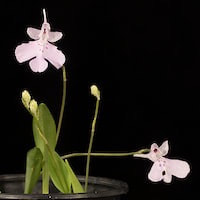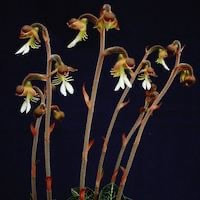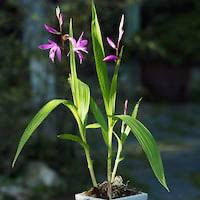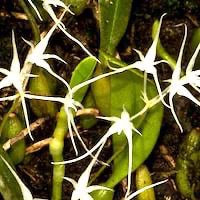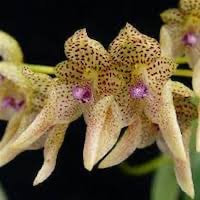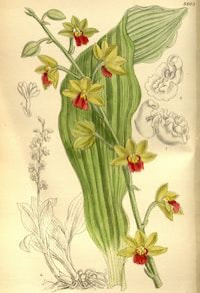MOR5- Men's Oriental 5 - In a grass of its own - Patchouli
|
Native Singaporean Orchid notes: Aerides Odorata
Aerides Odorata
Aerides odorata, also known as the Fragrant Aerides or Fragrant Orchid, is a widely distributed orchid species across the Himalayas, Southeast Asia, and India. It resembles Vanda orchids but is distinguished by its fragrant, waxy flowers and pointed spurs. The orchid is valued for its ornamental beauty and medicinal uses in various cultures. In India, its fallen fruits are used to heal wounds, while in Vietnam, its seeds are believed to treat skin disorders. Despite its traditional medicinal uses, rigorous scientific research is needed to confirm its pharmacological benefits and ensure safe usage. Conservation efforts are crucial to protect this orchid's natural habitats and sustain its cultural and medicinal significance. |
Therapeutic Orchid notes:
|
Amitostigma pinguicula
Amitostigma pinguicula, known as the Big Flower No Pillar Orchid, is utilized in traditional Chinese medicine for its detoxification properties. It is used across regions like Fujian, Zhejiang, Hubei, and Sichuan to reduce swelling, treat trauma, and counteract snake bites and poisoning. The orchid is also employed to manage conditions like haematemesis, where patients vomit blood. While valued in traditional healthcare, its medicinal efficacy requires further scientific validation through research and clinical trials. Conservation efforts are crucial to safeguard Amitostigma pinguicula and its medicinal heritage for future generations, ensuring sustainable use and preservation of biodiversity. |
|
Anoectochilus koshunensis Hayata
Anoectochilus koshunensis Hayata, also known as Gaoxiong Jinxian Lan (Gaoxiong golden thread orchid) in Chinese and Kaohsiung (jewel orchid) in Taiwanese, is a medicinal orchid found in Taiwan. In traditional Chinese medicine, it is used to "cool the blood and smoothe the liver," with antipyretic and detoxifying properties. It treats ailments such as tuberculosis-related haemoptysis, diabetes, bronchitis, nephritis, cystitis, convulsions, and snake bites. Scientific studies have isolated bioactive compounds like kinsenoside and unique sterols, suggesting potential medicinal benefits. Further research is needed to validate these claims and ensure safe use, while conservation efforts are essential to protect this orchid's natural habitats and cultural significance. |
|
Bletilla striata
Bletilla striata, known as Baiji (white mucilaginous root) or Purple Orchid, is a medicinal orchid found across China, Korea, Japan, and Vietnam. In Traditional Chinese Medicine, its tubers are processed into slices or powder for treating various conditions. It is used to reduce swelling, stop bleeding, and promote tissue regeneration. Bletilla striata contains bioactive compounds like bibenzyls and dihydrophenanthrenes, which exhibit antimicrobial properties and have potential applications in treating liver flukes and as gene carriers for anti-inflammatory therapy and cancer treatment. Conservation efforts are crucial to safeguard this orchid's habitats and preserve its role in traditional medicine and modern scientific research. |
|
Bulbophyllum kwangtungense
Bulbophyllum kwangtungense, also known as Guangdong Province stone bean orchid, is a miniature orchid species blooming from May to August. It thrives on rocks in forests across China, Hong Kong, and Lantau Islands. In traditional Chinese medicine, its pseudobulbs are used fresh or steamed and powdered, known for their cooling properties to relieve heat, nourish yin, and reduce swelling. It treats conditions like coughs, rheumatism, and mastitis, and its external application helps with traumatic injuries. Chemical analysis identified compounds like cumulatin and dibenzoxepins with potential antitumor properties, suggesting further research for cancer treatments. Conservation efforts are crucial to protect this orchid and its medicinal value. |
|
Bulbophyllum umbellatum
Bulbophyllum umbellatum, also known as Cirrhopetalum maculosum, is an orchid species found in the western Himalayas and Thailand, valued for its chemical composition and traditional medicinal uses. It contains cirrhopetalanthrin, a unique dimeric phenanthrene derivative that interests researchers for its potential pharmacological properties, though further studies are needed to understand its applications. In Ayurvedic medicine, it's known as "swarna jivanti," used for promoting longevity and overall well-being. This herb is considered rejuvenating and adaptogenic, aiding in stress management and vitality. Conservation efforts are crucial to safeguard Bulbophyllum umbellatum and its habitats, ensuring its sustainable use in traditional medicine and scientific research. |
|
Calanthe tricarinata Lindl.
Calanthe tricarinata, known as the triangular prism prawn spine orchid, is found in various regions of China and neighboring countries like Nepal and the West Himalayas. It holds traditional medicinal significance across these areas. In Nepal, the orchid's leaf paste treats wounds and eczema, while both leaves and pseudobulbs are used as aphrodisiacs. In Uttarakhand, the roots and leaves are used for jaundice and typhoid treatment. In China, the root is used to improve blood circulation, relieve muscle and joint pain, and stop bleeding. However, scientific evidence supporting these uses is limited, necessitating further research. Conservation efforts are critical to protect Calanthe tricarinata from overharvesting and habitat loss, ensuring its sustainability for future medicinal and scientific purposes. |
Other scent note
Scentopia Library Reference ingredient
Tanjong Tree - Sentosa's plants - Check details at Scentopia's scent library
Download the guided mediation that works best with this Orchid fragrance oil
| men_oriental_essential_oil_orchi_00005.mp3 | |
| File Size: | 105479 kb |
| File Type: | mp3 |

